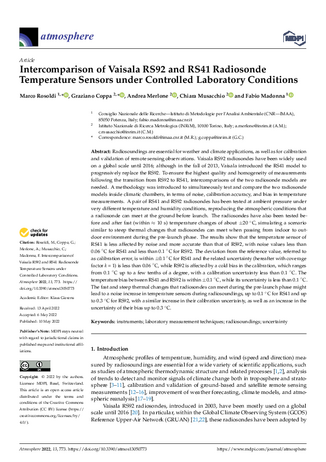Radiosoundings are essential for weather and climate applications, as well as for calibration and validation of remote sensing observations. Vaisala RS92 radiosondes have been widely used on a global scale until 2016; although in the fall of 2013, Vaisala introduced the RS41 model to progressively replace the RS92. To ensure the highest quality and homogeneity of measurements following the transition from RS92 to RS41, intercomparisons of the two radiosonde models are needed. A methodology was introduced to simultaneously test and compare the two radiosonde models inside climatic chambers, in terms of noise, calibration accuracy, and bias in temperature measurements. A pair of RS41 and RS92 radiosondes has been tested at ambient pressure under very different temperature and humidity conditions, reproducing the atmospheric conditions that a radiosonde can meet at the ground before launch. The radiosondes have also been tested before and after fast (within ≈ 10 s) temperature changes of about ±20 °C, simulating a scenario similar to steep thermal changes that radiosondes can meet when passing from indoor to outdoor environment during the pre-launch phase. The results show that the temperature sensor of RS41 is less affected by noise and more accurate than that of RS92, with noise values less than 0.06 °C for RS41 and less than 0.1 °C for RS92. The deviation from the reference value, referred to as calibration error, is within ±0.1 °C for RS41 and the related uncertainty (hereafter with coverage factor k = 1) is less than 0.06 °C, while RS92 is affected by a cold bias in the calibration, which ranges from 0.1 °C up to a few tenths of a degree, with a calibration uncertainty less than 0.1 °C. The temperature bias between RS41 and RS92 is within ±0.1 °C, while its uncertainty is less than 0.1 °C. The fast and steep thermal changes that radiosondes can meet during the pre-launch phase might lead to a noise increase in temperature sensors during radiosoundings, up to 0.1 °C for RS41 and up to 0.3 °C for RS92, with a similar increase in their calibration uncertainty, as well as an increase in the uncertainty of their bias up to 0.3 °C.
Title
Intercomparison of Vaisala RS92 and RS41 Radiosonde Temperature Sensors under Controlled Laboratory Conditions
Authors
Rosoldi, M.; Coppa, G.; Merlone, A.; Musacchio, C.; Madonna, F.
Published
by Atmosphere (Atmos) at 2022-05-10
Abstract
